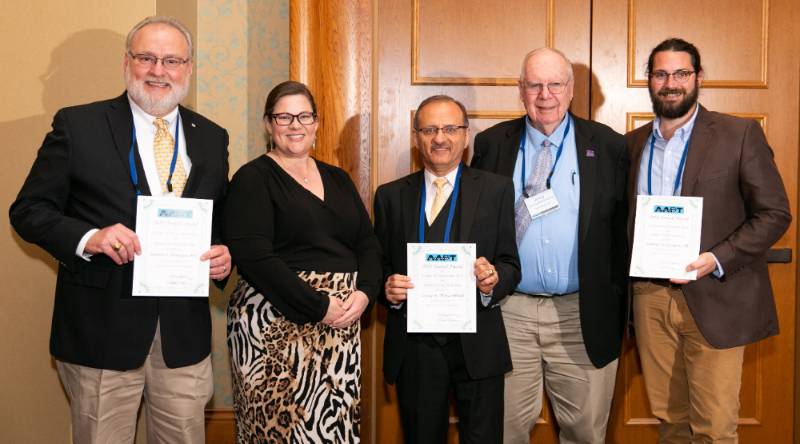LSU, LTRC Researchers Win Best Paper for Sustainability Work
October 30, 2019

Best Paper Award winners from left to right, Gaylon Baumgardner , AAPT President Audrey Copeland, Louay Mohammad, Bill Daly, and Sam Copper III
BATON ROUGE, LA – Researchers from LSU’s Department of Civil & Environmental Engineering, Department of Chemistry, and the Louisiana Transportation Research Center were recently honored at the 2019 meeting of the Assocation of Asphalt Paving Technologies with the Best Paper Walter J. Emmons Award for their report, “Impact of Various Crumb Rubber Modifications on Asphalt Binder and Mixture Properties.”
Their research explores the performance benefits of using sustainable materials in flexible pavement construction, specifically the use of waste tires, or crumb rubber, as an asphalt binder modifier used in asphalt mixtures.
Leading the team of researchers was LSU Civil & Environmental Engineering Professor Louay Mohammad. He was joined by LSU Chemistry Postdoctoral Researcher Sreelatha Balamurugan, LSU Chemistry Emeritus Professor William Daly, LSU Chemistry Professor Ioan Negulescu, LTRC Materials Research Administrator Samuel Cooper III, LTRC Director Samuel Cooper Jr., and Executive Vice President of Paragon Technical Services Inc. Gaylon Baumgardner.
“The project was in response to [the Department of Transportation and Development’s] search for sustainable options to reduce the rising costs of asphalt pavement materials without compromising performance,” Mohammad said. “One such alternative is the use of crumb rubber in asphalt binders or asphalt mixtures.
“Through incorporating crumb rubber from waste tires into Louisiana asphalt mixtures, researchers are not only improving the durability and sustainability of local infrastructure, but are also furthering sustainability efforts that have been in motion for years across the nation.”
The findings of the research team have resulted in updates to DOTD’s 2016 rubber specifications, which now place a limit on the maximum allowable rubber modification rate at 10%. The new specification also allows the use of cryogenically ground crumb rubber, which the previous specification did not allow.
The project was funded by LTRC and capitalized on the unique capabilities and collaboration among LSU Civil Engineering, LSU Chemistry and LTRC researchers.
“Utilizing each department’s specialties and technology, [we] studied the impact various crumb rubber modifications had on rutting and cracking of asphalt mixtures as compared to control mixtures,” Mohammad explained. “The most common crumb rubber modifier packages were evaluated because those are what local contractors are using in this state.”
Like us on Facebook (@lsuengineering) or follow us on Twitter and Instagram (@lsuengineering).
###
Contact: Joshua Duplechain
Director of Communications
225-578-5706 (o)